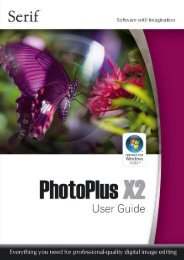PhotoPlus X6 User Guide - Serif
PhotoPlus X6 User Guide - Serif
PhotoPlus X6 User Guide - Serif
You also want an ePaper? Increase the reach of your titles
YUMPU automatically turns print PDFs into web optimized ePapers that Google loves.
Soft-edged and hard-edged selections<br />
Manipulating Images 93<br />
Anti-aliasing and feathering are different ways of controlling what happens at<br />
the edges of a selection. Both produce softer edges that result in smoother<br />
blending of elements that are being combined in the image. You can control<br />
either option for the Standard and QuickShape Selection tools, using the Feather<br />
input box (or slider) and Anti-alias check box on the context toolbar.<br />
• Anti-aliasing produces visibly smooth edges by making the selection's<br />
edge pixels semi-transparent. (As a layer option, it's not available on<br />
the Background layer, which doesn't support transparency.)<br />
• If an anti-aliased selection (for example, one pasted from another<br />
image) includes partially opaque white or black edge pixels, you can<br />
use Matting options on the Layers menu to remove these pixels from<br />
the edge region, yielding a smoother blend between the selection and<br />
the image content below. (Fully opaque edge pixels are not affected.)<br />
• Feathering reduces the sharpness of a selection's edges, not by varying<br />
transparency, but by partially selecting edge pixels. If you lay down<br />
paint on a feathered selection, the paint will actually be less intense<br />
around the edges.<br />
• Threshold converts a feathered, soft-edged selection into a hard-edged<br />
selection (use Select>Modify>Threshold). As with feathering, you<br />
won't see an immediate effect on the image, but painting and other<br />
editing operations will work differently inside the selection.
















